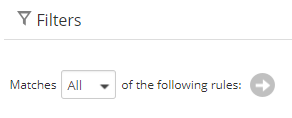Filters in Emplifi Agent
Filters are used to limit or select the data that will be included in a process, such as a report, a utility, or a search. Many of the reports and utilities in Emplifi Agent have a Filters view. Filters are also available on the Case Search window, and in several other places in the system. For more information, see Searching for a Case.
For reports and utilities, it is important that you include filters so that the report or utility does not process every single case in your system. Most reports display a warning if you attempt to run them without any filters.
To add a new filter:
Click the Filters tab on the report or utility window.
From the Filters Categories list, select the Menu icon next to the category.
Drag and drop the category into the Filters pane.
To remove a filter:
Select the Menu icon next to the category filter that you want to remove.
Drag and drop the category into the Filters Categories list.
Each filter can contain the following information:
Field | Description |
|---|---|
Category | Enter the name of the category on which you want to filter the selection. Standard code browsing functionality is available for this field. For details, see the Browsing for Codes section on page Codes and Browsing.
|
CID | This is the category ID of the category selected in the previous field. It is filled in automatically when you select the Category and cannot be modified. |
Operator | Select the type of comparison that you want to perform. For more information, see the Using Operators section below. |
Time Frame | If the selected category is a date category, you can select a time frame on which to filter. For other category types, this field is grayed out. |
Value, From | If the selected operator is used to compare to a single value or group of values (such as = or IN), you enter the values into this field. For categories that define codes, you must select a valid code. Standard code browsing functionality is available. For details, see the Browsing for Codes section on page Codes and Browsing. If the selected operator is used to compare to a range of values (such as BETWEEN), you enter the starting value in this field. When using IN or NOT IN operators, you can separate multiple values using a semicolon. If you use the code browse window, it will remain open after each selection so that you can easily select multiple values. Also when using the browse window, it is possible to select a folder level in the hierarchy by holding down the [Shift] key while clicking on the folder name. If entering dates for time frames, see Time Frames and Dates on Reports and Utilities. |
To | If the operator is used to compare to a range of values, you enter the ending value in this field. Otherwise this can be left blank. |
Using Operators
Each of the options that are available in the Operators field are listed below, along with a description or examples of their use.
Operator | Description/Examples |
|---|---|
= (equals) | Only those records where the specified category exactly matches the value in the Value, From field are selected. Comparisons on text fields are case-sensitive |
<> (not equals) | Only those records where the specified category contains some value other than the one entered in the Value, From field are selected. |
BETWEEN | Use this operator to select a range of values. The beginning (low end) of the range should be specified in the Value, From field. The end of the range should be specified in the To field. The From and To values are also included in the range. If the filter category is a date category, the operator defaults to BETWEEN. |
IN NOT IN | Use the IN operator to match to a set of specific values. Specify the values that you want to match in the Value, From field. Separate items in the list with a semicolon. You can also select multiple values using the code browse window. The window remains open after each selection to allow you to easily select multiple codes. You can have one of the values be NULL. Either the IN or NOT IN operator will allow NULL values for the filter. When you add NULL to the end of a list of values, the filter will return data that has the specified values or where the value is blank. |
LIKE NOT LIKE | Use the LIKE operator to perform searches for values that follow a specific pattern. Use the '%' character as a wildcard to match 0 or more characters. Use the '_' character to match any single character. Examples:
You can also combine several wildcards in a single expression. For example, "%call%" would match any word that contained "call" somewhere within the word (including at the very beginning or very end). We do not recommend that you use the Case Text column with this operator. Refer to the CONTAINS operator below if you need to search text. |
CONTAINS | Use the CONTAINS operator to search for words within columns that have been defined to have a text index. The Case Text column can be set up to allow this feature. If the feature is not enabled for a column then a message displays indicating that you are missing an index. To use this feature, refer to Case Text Searching. |
IS NULL IS NOT NULL | A null value is a field that does not have any value in it.
You do not need to specify a Time Frame, From, or To value when using these operators. |
< (less than) > (greater than) | Standard mathematical operators for comparing numeric values. |
ALL <> ALL NOT IN ALL NOT LIKE ALL NOT NULL | These operators are only applicable when applied to an issue-level field (C-code). They cause the system to only select cases where all of the issues on the case match the specified criteria. |
(+)= | This is a special operator used only for the Case Listing report. It is used in combination with the Issue/Text Join field on the report options screen to do an outer join in a filter. For more information, see Case Listing Report. Example: You would then add the following filter to the report:
If you used the normal equals (=) operator, the issue row would vanish if it had no text, because the outer join would change to an inner join as a result of the filter being added. |
Soundex | Soundex is a special search technique that compares the relative sounds of two words, rather than their spellings. For example, 'plane' and 'plain' would match in a Soundex search, as would 'phone' and 'fone'. Soundex is intended primarily for searches on the last name or street name in an address record. You can theoretically perform a Soundex comparison on any text field; however performance may be extremely slow because other fields have not been optimized for Soundex searches. |
Enhanced Filtering
If an administrator enables the Enhanced Filtering functionality, you can choose "OR" filtering when you add filter categories to your filter list. This means data is filtered based on one filter category or the next filter category on your list.
to Administrators: To enable the Enhanced Filtering functionality, on the Custom Configuration page, enter the Section field as Reporting, the Key field as EnableEnhancedReporting, and the Value field as Y. For more information, see Configuration: Custom.
To add "OR" filters:
After you select the Filters tab, you will see the following:

In the Options box, you can select "All" to match all the selected filter categories (the default) or "Any" to match any of the selected filter categories.
Use the Drag and Drop operation to add filters.
Click the Arrow button to add an indented "OR" rule under your filter.
Enter the settings for the filter using the same options in standard filtering. Below is an example of the Enhanced Filtering page.

When you are finished setting up your filters, click the Save button.
To delete a filter:
If you add a filter that you no longer want to use, click the Delete button or drag the filter category back to the side panel.
The following utilities do not use the Enhanced Filtering, even if you are configured for this functionality: eGiftCard Rebalance Utility, Enclosure Approval Utility, Letter Proofing Utility, and Address De-Duplication Utility.
